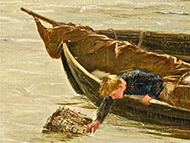Where Do You Stop?
(a sample)
Chapter 1
I WAS STANDING in a locker in the Purlieu Street School on an August night, when a locker was a hot place to be. I was ten. I would be attending the Purlieu Street School in the fall, when I started seventh grade, if the building was finished in time.
The Purlieu Street School was supposed to get the schoolchildren of Babbington — my home town, the clam capital of America — off split session once and for all. Split session was a means of fitting more students into a crowded school system than it ordinarily would hold. Since the end of World War II, Babbington had been growing so quickly that people couldn’t adjust their thinking to it, growing “by leaps and bounds,” as people said then. In developments all over town, carpenters built houses furiously. The air resounded with their hammering. Families moved into the new houses as fast as they went up. During the sixth grade, a new boy or girl seemed to show up in class every week. The schools were chronically overcrowded, and about once a year the need to build yet another one took everyone by surprise.
The point when a new school was necessary always arrived before the point when it was built, and no one recognized the point of necessity until it was past, although I think that if the computational power had been available the point of necessity might have been predicted, since each child was an atom, a mathematical point, in the social scale of things. Each newborn, each child reaching school age, each child reaching a certain grade level could have been plotted on a graph as a point, and if that had been done, then there would certainly have been a singular child on that graph whose arrival in Babbington, by birth or immigration, could be predicted to break the back of the system, one child for whom there would be no floor space at nap time in the Babbington kindergarten, no slice of meat loaf in the elementary school cafeteria, no locker in the high school gym unless another new school was built. Alas, in those days before integrated circuits on semiconductor chips, people had to rely on pencils, paper, mechanical adding machines, and brains, so the arrival of the child who broke the back of the system was always a surprise, and it always precipitated a scramble to build a new school.
In the period between the time when the need for a new school was finally recognized and the time when that new school actually opened, space was often so short that the sessions were split: half the students went to school only in the morning, the other half only in the afternoon. I spent most of the sixth grade on split session. An advantage was that I was free to watch “Fantastic Contraptions” on television every day at noon. This program was hosted by Fred Lucas and Florence Hill, who had once been fairly successful in the movies, and then, as Freddie and Flo, had been enormously popular on radio, where they had a weekly comedy program. The Freddie and Flo Show didn’t make the transition to television, and for a while their career seemed to be over. I guess they were lucky to get a job as hosts of a giveaway program in the obscurity of midday. It may have been Siberia to them, but it was the perfect time for me, since the noon hour was the gap between school sessions. On the shaky base of “Fantastic Contraptions” Freddie and Flo built a new popularity as scatterbrained humorists. Later, as their popularity peaked, they began appearing in special shows on nighttime television, too, but they were different people there, and everything they did at night was cautious, calculated, and aimed at adults. The Flo and Freddie I admired were not the Flo and Freddie of their nighttime specials, not the Flo and Freddie of strained artiness and pronounced significance who are trotted out now and then in television biographies illustrated with clips from those specials. I preferred the everyday variety — improvisational, quick, uneven, occasionally silly, always fascinating.
The giveaway program, a feature of the early days of television, was a type of show in which members of the audience were rewarded simply for being there. They didn’t have to answer questions or perform stunts to collect prizes; they just had to show up. That seems unlikely today, I suppose, but the medium was very young then, and broadcasters were still uncertain about how to find and build an audience for it. Some genius must have realized that people would want to watch other people being given things, and that the viewers would come back again and again to see more people get gifts, especially if the people seemed to have done nothing more to deserve these gifts than getting themselves to the television studio, because it seemed to validate the ultimate in groundless hopes: that fate might reward a person simply for being alive. This genius must also have understood that it wouldn’t be a warm, selfless pleasure at witnessing others’ good fortune that would keep the viewers tuning in. It would be envy.
At first, the hosts of giveaway shows didn’t do much more than chat with people for a minute or two before handing over some dishware or a reclining chair, but soon there arose an informal and undeclared competition. The people who chatted with the host began trying to be more interesting than their fellows in the audience: to be funnier, more foolish, or more intelligent, or even to seem more miserable than the others. These distinctions were rewarded. A set of silverware might be added to the dishes, or an ottoman to the lounger. In time, of course, the format for displaying or demonstrating one’s distinctions from one’s fellows was codified, formalized, and specified for each show, and the competitive type of show was born. This eventually led to the quiz show, but there was an intermediate type of show in which people had to perform humiliating stunts for cash and prizes. I do not count these as quiz shows since the contestants weren’t required to know anything. This type of show enjoys a revival from time to time. Part of its appeal is that it allows the viewer to cluck and guffaw at the ridiculous lengths to which his revolting fellow creatures will go, the depths to which they will stoop, the humiliation they will endure for a few dollars or a car or a set of pots.
“Fantastic Contraptions” at first lay on the dusky line between the fading giveaway program and the coming competitive program, but over the course of its history it moved with the times toward out-and-out competition. In the first part of the show, amateur inventors would bring their creations onstage and explain and demonstrate them. This part was a lot like show-and-tell. One after another, the inventors presented their gadgets. Then, at the end of the show, each inventor would return and stand before the audience to receive its applause. The one who got the most applause won a prize of some sort. I could watch most of the show before I went to school, but I had to dash outside and catch the bus, so I couldn’t see the finish, when the winning inventor was rewarded. For many viewers — not for me, but for many others, I think — the parade of gadgets and gadget makers would have been boring without Freddie and Flo, who made it hilarious. They had a running gag of behaving as if they had just blundered onto this show, unprepared, and every now and then, when something particularly outrageous occurred, they would turn and look at each other, asking, silently, “How did we get into this?” I would laugh at that look every time. The fact that they could make me laugh at the same thing again and again seemed to me a remarkable achievement. They also asked funny questions about the gadgets and maintained a seamless line of banter, apparently improvised, that frequently wandered far from the matter at hand, leaving the inventor standing to one side, puzzled and speechless, wondering whether he’d been forgotten, until, after a circuitous, hilarious, and sometimes quite personal digression, Flo and Freddie returned, always, unerringly and brilliantly, to the precise point in the discussion of the invention that had set them off on their ramble, catching the inventor flat-footed and woolgathering, to the delight of the audience.
The fantastic contraptions on Flo and Freddie’s show were mechanical or electromechanical. In every case, a contraption’s announced purpose was accomplished — if it was accomplished — with a great deal of clattering and clanking and whizzing and whirring. Wheels turned, gears spun, armatures moved, bells rang, lights flashed. Many — it would probably be more accurate to say most — of the machines seemed to be failures. That is, they failed to accomplish what their inventors claimed they would. Many others seemed to have no purpose at all, and their inventors never even claimed any for them. When asked what the thing they held so proudly was supposed to do, they would just say something like, “Well, now, Freddie and Flo, I’m not going to tell you what this here gadget of mine does. I’m going to let you figure that out for yourself. [Here Freddie and Flo would exchange that look that got me every time.] What say we just flip this little switch here on the side and see how she goes?” I could tell, from the moment an inventor began talking along those lines, that the machine was going to be one of those that accomplished nothing, one of the ones that hummed and spun and rattled and clanked itself into a heap of scrap while the audience roared and Flo and Freddie exchanged looks.
Every machine, whether it had a reasonable purpose or not, included a lot of redundant or apparently useless parts. Off to the side a pinwheel would whirl, for example, catching the light, catching the eye, but contributing nothing at all to the declared purpose of the machine. I used to wonder, when I watched that distracting pinwheel spin and flash, what had gone wrong in the mind of the inventor. What had made him include this useless bit that glittered so dazzlingly, drawing attention to itself and its uselessness? How had the inventor allowed himself to get so carried away? Why hadn’t he heard a reasonable inner voice telling him that enough was enough? When his contraption was complete and he stood back to admire it, didn’t he notice this vestige of a lapse in his thinking, this souvenir of a stroll down a mental dead end? Wasn’t he embarrassed by it? Apparently not. Apparently he didn’t even notice it, though it stood out like Cyrano’s nose. I noticed it, everyone else watching the show must have noticed it, and Freddie and Flo exchanged quips about it, but the inventor seemed entirely unaware of it, grinning helplessly in his ignorance, unaware of the cause of all the hilarity. I was embarrassed for him and others like him, even ashamed for them, standing in front of us with their mistakes showing, but Flo and Freddie never seemed to take advantage of them. Not at all. The oddities may have sparked their humorous remarks, but those remarks were never made at the expense of the inventor. They never humiliated the poor guy. Instead, they would seize upon the superfluity in the machine — its worst, most embarrassing mistake — and from it they would wander off into a rambling anecdote about Flo’s bumbling uncle. This seemed to me wonderfully generous. Right in front of them they had the source of many an easy laugh, but they barely used it, just took off from it, and in doing so actually distracted us from it. Freddie might arch his enormous eyebrows at the superfluous whatsit, and Flo might flick it with a long-nailed finger and shrug when it spun uselessly, but then they would take off, leading us elsewhere, diverting us, making the useless appendix seem a small and forgivable error. I admired them for this skill and for the generosity that seemed to underlie it.
|
|
|
|
|
|
|







